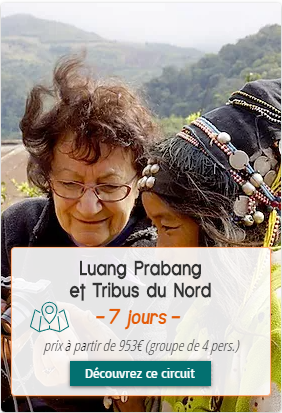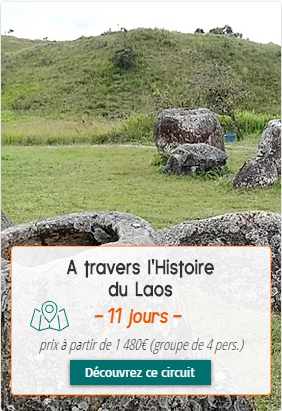The mysterious Akha tribe of northern Laos
Dernière mise à jour : 7 juil. 2023
Laos is still home to many ethnic groups, including the Hmong, Yaos and Akhas. These "Lao-soung" (Lao from above) live in small villages, often on the bangs of modern society, in self-sufficiency high up in the mountains.
In this article, we take a look at the Akha tribe, the most mysterious and least known of them all.

What are the origins of the Akha ethnic group?
The Akha people belong to the "Lao soung" ethnic group, which groups together the ethnic groups living in the mountain heights. They originate from south-west China, more precisely from the Yunnan region. The history of this tribe is rather vague, as their language, belonging to the Tibeto-Burman family, is purely oral. The texts that have been found come from foreign missionaries who shared their daily lives.
These writings tell us that the Akhas began their migration in Burma. They then moved on to northern Thailand, the far north of Laos, and as far northwest as Vietnam, fleeing the civil war that raged in Burma in the early 19th century.
Today, there are some 400,000 members of the various Akha tribes, 80,000 of whom live in Laos. The stagnation of this number for several decades is explained by the retreat of these people into the mountains, and their hermeticism to medical advances.
Where do the Akha tribes live today?
A semi-nomadic people, they traditionally live at high altitude in mountainous areas, moving their village every 10 years or so in search of more fertile soil. They practice itinerant slash-and-burn agriculture, which means they have to look for new land on a regular basis.
They have preserved and protected their ancestral customs over the centuries, and live on the bangs of urban areas. Attached to their identity and way of life, few of their villages have access to running water or electricity.
What activities do the Akha people engage in?
This is one of the most isolated peoples to be found in Southeast Asia. Traditionally, they grew poppies and rice, the mainstay of their diet. Since the government decree banning poppy cultivation in Laos, the Akha tribes have adapted and found new sources of income.
In addition to rice, they now grow a variety of vegetables for sale, such as chillies and soybeans. They also raise livestock for their own consumption and for resale, notably buffalo, pigs, chickens and other poultry.
Adept at handicrafts, the women make, weave and embroider magnificent costume ornaments, which they sell at local markets. During your trip to the Akhas, you'll have the opportunity to buy beautiful souvenirs to offer to your loved ones.

What are the customs and traditions of the Akha tribes?
The Akha ethnic group are animists, believing in the good and evil spirits that animate natural elements such as forests and rivers. They also attach considerable importance to their ancestors, and are able to recite their family tree from memory, spanning 50 to 60 generations.
The Akhas are traditionally self-sufficient, making the most of the resources nature has to offer. In keeping with their animist beliefs, they worship the "spirits of the forest", who provide them with sustenance. Thus, the gathering of seeds, fruits and medicinal herbs, an activity reserved exclusively for women, is part of their daily routine. They also collect wild animal eggs and all kinds of insects. As for the men, they hunt. For some years now, this activity has been developing, as the crossbows traditionally used are gradually being replaced by more efficient hunting guns. Finally, both men and women fish in the rivers surrounding their villages to supplement their diet.
Once on the bangs of society, today they are beginning to open up their villages to eco-tourism, in order to diversify their sources of income. This is particularly the case in Thailand, where these practices are sometimes adapted to mass tourism. In Laos, this more unspoiled people encounter fewer travellers, which reinforces the intensity of intercultural exchanges. Some villages are even starting to send their inhabitants to work in the city.


Deux élémeAkha villages: a wooden door and a ceremonial swing.
The wooden "spirit gate" at the entrance to the village is usually made of bamboo. Its spiritual role is to protect villagers leaving the village from disease, wild animals, evil spirits and, more generally, from misfortune. This small structure attracts good spirits and repels evil ones. It traditionally marks the separation between the inside of the village, reserved for human beings and domestic animals, and the outside, the realm of the spirits. The gate is usually decorated with sculptures of male and female figures.
These decorations are also found on the roofs of Akha houses, and serve as a secondary means of securing and protecting homes. Traditional houses are divided into two sections: one for women and children, the other for men. Couples sleep in separate beds, and live in separate areas of the house.
The swing is built on one of the highest points in the village. Sacred, it is used during a ceremony marking the end of work in the rice fields, to ask the spirits for the fertility of their land.
Out of respect for their beliefs, we won't be showing you photos of their swings, but you'll have the pleasure of discovering their customs by contacting our Luang Prabang-based team to create your tailor-made trip.
The traditional Akha costume distinguishes each tribe...
The different sub-branches of the Akha ethnic group can be distinguished by their clothing and headdresses. This is particularly true of women. The colors, compositional elements and shapes reveal the wearer's geographic and cultural origins.

Each woman makes her own traditional outfit, used for special occasions and animist celebrations. The indigo dye used to color these garments is also made by the Akha women, and the cotton is spun by hand. The complete outfit consists of a dress, leggings and a headdress designed by each woman herself. These headdresses are all unique. They are embellished with pearls, colorful embroidery, silver coins and feathers. They also provide information about age, marital and social status within the community.
We hope you've enjoyed this article and that the Akha woman's smile in the video above has inspired you to go and meet this unique tribe. Start planning your trip to Laos by contacting Vasanath, Phasouk or Charly to create your private group tour.
Here are some other links that might interest you:
#tribulaos #akha #costumes #cultureanimiste #tradition #aventurelaos #trekaulaos #decouvertedestribus #articlelaos #voyage #rencontre #agencedevoyage #luangprabang #laos #nordulaos #equipefrancophone #jungle #randonature #femmeakha #modedevie #ethnies #montagne





